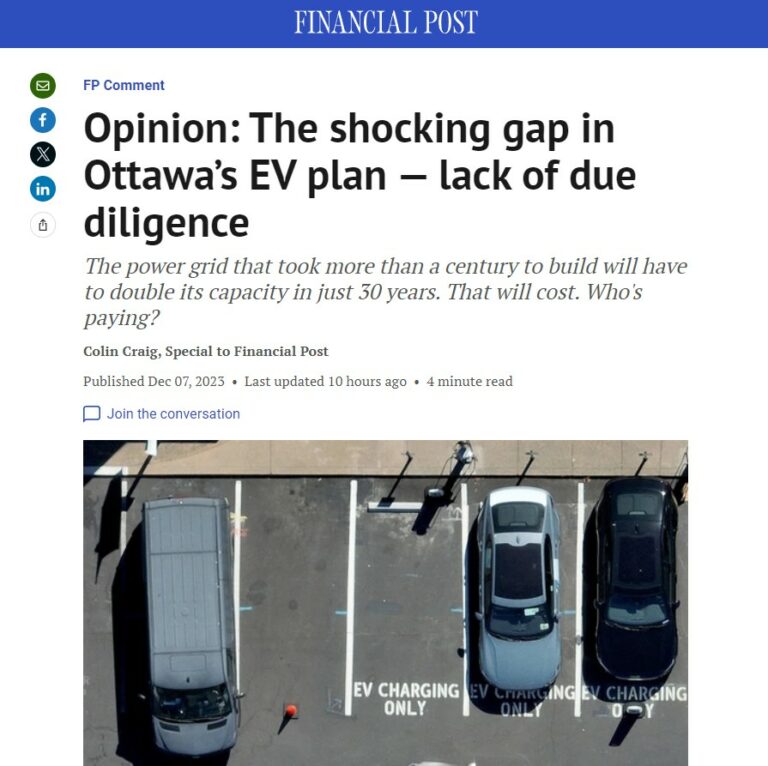FINANCIAL POST COLUMN: The shocking gap in Ottawa’s EV plan — lack of due dilligence

What would happen to your electricity bill if all your neighbours started driving electric vehicles (EVs)? This is not a hypothetical question. The federal government’s plan is for Canadians to be driving EVs en masse in a little more than a decade. Ottawa has banned the sale of new gas-powered passenger vehicles as of 2035 and the government has committed tens of billions of taxpayer dollars in grants and incentives to the makers of EV batteries.
You’d think anyone writing such a plan would understand it’s crucial to know what the coming flood of EVs will do to Canadians’ electricity bills. But research by SecondStreet.org suggests no one does know the answer — or has even addressed the question in a serious way. After we filed Freedom of Information requests nationwide, governments generally responded that they simply don’t know.
To be sure, it’s good that consumers have EVs as a transportation option. Competition is good for consumers. But it’s one thing for Canadians to have the option of buying electric cars, it’s quite another for the government to mandate such vehicles.
In addition to the serious implications of having Canadians’ choices regarding such important transportation choices taken from them and instead made for them by the federal government, mandating EVs comes with significant consequences for electricity grids.
EVs use lots of electricity. According to Energy Minute, an organization that follows energy issues closely, an electric car increases a home’s electricity usage by “25-35 per cent.” Consider that many households have more than one vehicle and it’s easy to see how a wave of EVs will require large amounts of power. Where will it all come from?
Part of the answer is to charge electric vehicles at night when demand is lower and electric utilities have more power available. Analysis provided to SecondStreet.org from electricity providers across Canada show they’re counting on consumers doing just that. But many utilities conceded more capacity will be needed and they’re looking at “renewables” as one option. The obvious problem with renewables, of course, is that wind and solar struggle when the wind isn’t blowing or the sun shining — which it doesn’t do at night.
To make matters even more challenging, the federal government is pushing provincial governments to stop using natural gas and oil for power generation. That won’t affect provinces like Quebec, Manitoba and British Columbia much as they rely heavily on hydro power. But Alberta, Saskatchewan and. to a lesser extent, Ontario depend more on natural gas for power and certainly will be affected.
The Canadian Climate Institute expects that regulatory changes and the push for electric vehicles mean electrical grids will need twice as much power generation capacity by 2050. The electricity infrastructure that took more than 100 years to build will need to double in less than 30 years.
In addition to having to generate more power, distribution grids across Canada will require upgrades. That means the power lines to your street and home and the transformers in your neighbourhood. On many Canadian streets the existing electrical infrastructure simply can’t handle a large increase in demand. SecondStreet.org obtained a report from SaskPower, Saskatchewan’s power utility, that found a cluster of 22 homes could only handle 11 electric cars before outages would occur.
In a document SecondStreet.org obtained from Manitoba Hydro, the utility noted that upgrades to accommodate electric vehicles will lead to higher rates, which will especially affect low-income Canadians because electrical costs represent a larger share of their household budgets. The utility also noted that all ratepayers will be affected — so even if you don’t own an electric vehicle, you will still be paying for those that do.
In sum, though some utilities recognize that rates will rise in order to support EVs, none knows exactly what the effect will be as they spend billions to upgrade their systems in preparation for EVs. It obviously would be better if utilities did have these figures but let’s not forget: this isn’t their idea — it’s Ottawa’s. Before the federal government went barrelling down the EV highway it should have calculated the implications of its decision — province by province — and shared its findings with the public.
Until proper due diligence has been conducted, the only reasonable option is to pause both the ban on gas-powered vehicles and the push for EVs. Only when Canadians know how Ottawa’s plan affects their wallets will they be in a position to judge it properly.
Colin Craig is the president of think tank SecondStreet.org.
This column was originally published on December 7, 2023.
You can help us continue to research and tell stories about this issue by making a donation or sharing this content with your friends. Be sure to sign up for our updates too!


